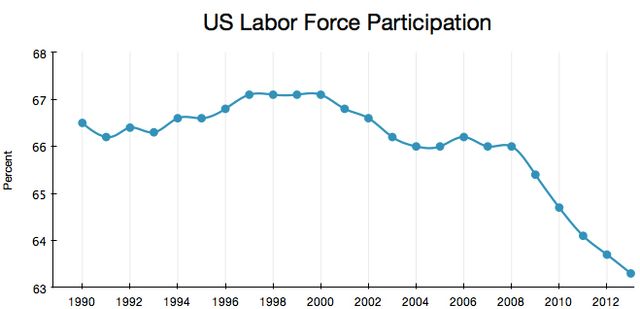Mounting Unemployment in America, Hundreds of Thousands Drop out of the Workforce

The US economy added 88,000 jobs in March, far fewer than the previous month and less than half the total economists had predicted, according to the Labor Department’s latest jobs report. The figures point to deepening slump in the United States and the continuing high levels of joblessness, even as the government launches a new round of austerity.
According to the Labor Department’s report, a staggering 496,000 people dropped out of the labor force in March, presumably for the most part because they concluded that work was not available. Perversely, this brought the official unemployment rate—based on the number of people recently and actively looking for work–down to 7.6 percent.
The March figures were the first reported since the beginning of $1.2 trillion in spending cuts, which are being phased in gradually. Some 7,000 government jobs were lost during the month, adding to the more than 700,000 such jobs eliminated since 2008.
While the sequester cuts are only beginning to be felt, over one million federal workers are set to begin furloughs this month. According to the Congressional Budget Office, the sequester cuts are going to result in the equivalent of 750,000 full-time job losses throughout the US economy.

Chart showing the fall in the proportion of US workers in the labor market
Stock values fell on the unexpectedly bad jobless figures, closing the worst weekly performance for the S&P 500 so far this year. For the week, the S&P 500 was down by one percent, and nearly every major global stock index declined even more.
March’s disastrous jobs report accompanies equally bad news from the other side of the Atlantic, as economic activity in the euro zone shrank again last month, raising fears of yet another quarterly contraction.
Earlier this week, the Japanese central bank responded to that country’s continued economic stagnation by initiating a $1.4 trillion money-creation program that has the effect of devaluing the country’s currency and boosting the competitive position of its national industry.
The White House responded to the worst jobs figures in almost a year with its typical refrain about a mythical economic recovery, stating that “today’s employment report provides further evidence that the U.S. economy is continuing to recover from the worst downturn since the Great Depression.”
Meanwhile, the number of people applying for unemployment benefits jumped to a four-month high, the US Labor Department said Thursday. The number of people seeking jobless pay rose by 28,000 last week, to 385,000.
But even as more people line up for unemployment insurance, benefits are being slashed. Starting this month, pay to recipients of extended unemployment benefits is being cut back by 11 percent, as a result of the sequester cuts.
The Labor Department also said that the percentage of working-age people who are in the labor force fell to 63.3 percent, the lowest level of the current downturn and the lowest level since 1979, before tens of millions of women entered the workforce.
Over the first quarter of this year, the US economy has created 168,000 new jobs per month. It needs to create about 150,000 jobs every month to keep up with population growth.
As the Economic Policy Institute (EPI) noted in its commentary on this month’s figures, the first quarter’s job creation rate “is not even close to adequate; at that rate, we would not return to the prerecession unemployment rate until late 2019. To get back to the pre-recession unemployment rate in three years, we would need to add 320,000 jobs every single month–almost double our current rate.”
Commentators pointed out the increasing absurdity of an official unemployment rate that drops any time the employment situation worsens. The EPI’s Heidi Shierholz noted that, if the actual labor force is compared to the Congressional Budget Office’s estimate of the “potential labor force,” there are 4 million people “missing” because they believe no jobs are available.
“If those workers were in the labor force looking for work, the unemployment rate would be 9.8 percent instead of 7.6 percent,” she concluded. “Currently, the unemployment rate is hugely underestimating the amount of labor market slack.”
Wages, meanwhile, continue to stagnate. Average hourly wages have increased by only 1.8 percent over the course of the past year. Meanwhile consumer prices grew by 2 percent, meaning that real wages fell. Median household incomes in the United States have fallen 5.6 per cent since 2009, when the figure was over $56,000, to $51,404 in the beginning of this year.
Most of the jobs being created pay lower wages than those eliminated during the crash. The Financial Times reported this week that the US has lost two million well-paying clerical jobs since 2007, according to data from the Bureau of Labor Statistics.
In contrast to the destruction of these relatively well-paying jobs, the newspaper reported that a number of low-paid employment categories have grown significantly since the crash. For instance, the number of personal care aides in the United States has grown by 390,000 since 2007. The newspaper noted that the average wage for clerical work was $34,410 annually, compared to $24,550 for personal care and even less for a typical food service job.
Continuing mass unemployment and falling wages, on the one hand, and the systematic destruction of government jobs and the slashing of unemployment benefits, on the other, are by no means coincidental. Far from responding to the situation with any move to combat unemployment, the Obama Administration is carrying out a policy that will eliminate hundreds of thousands of jobs while dramatically worsening the conditions of life for workers and the unemployed.
The White House, working together with the Republicans, is deliberately seeking to use the high unemployment stemming from the crisis that erupted in 2008 to drive down the wages and living standards of workers, aiming directly to boost the profits of major corporations and incomes of the super-rich.

